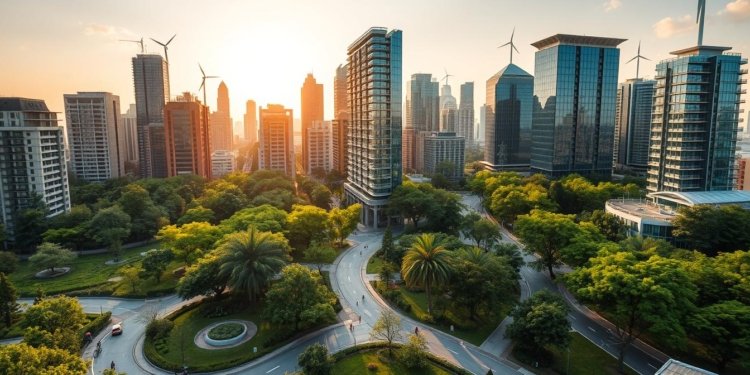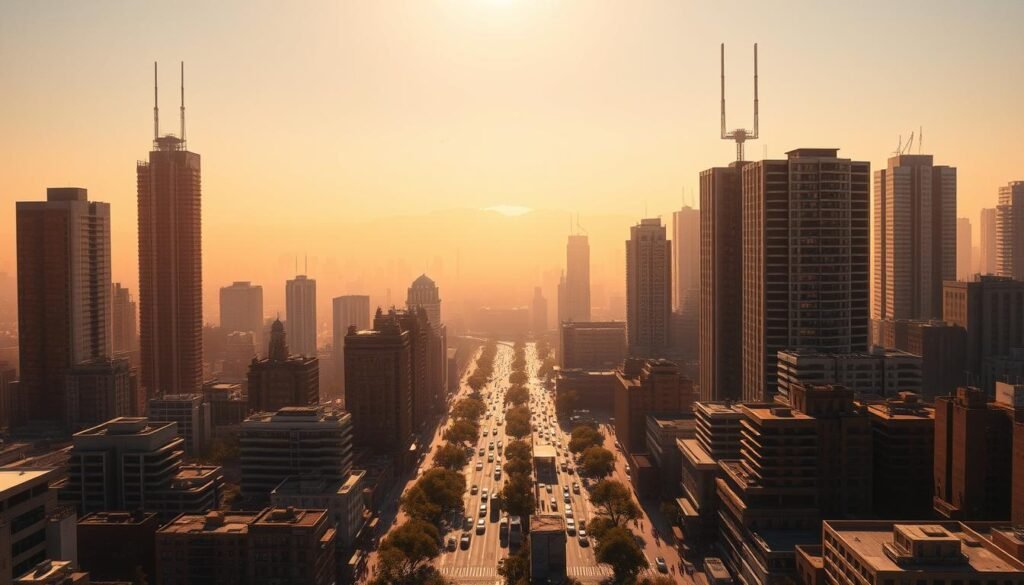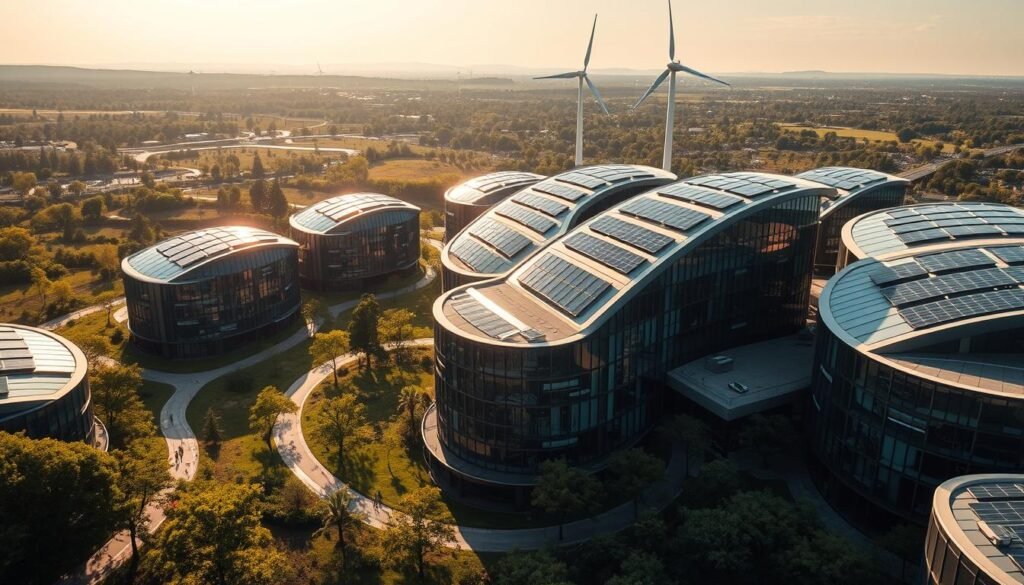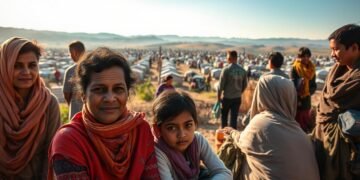Did you know that poorly designed cities contribute to climate challenges and strain energy resources? With over 56% of the world’s population now living in metropolitan areas, the need for smarter development has never been greater.
North America alone has seen a 20% growth in its cities since 2010. This rapid expansion demands solutions that balance economic growth, social equity, and environmental health. Without proper strategies, issues like pollution and waste mismanagement will only worsen.
From eco-friendly districts like Germany’s Vauban to overcrowded hubs struggling with air quality, the contrast is stark. The UN’s Sustainable Development Goal 11 highlights the urgency—creating resilient communities is no longer optional.
Key Takeaways
- Over half the global population lives in cities, stressing resources.
- North American urban areas grew 20% in the last decade.
- Smart development balances economy, equity, and ecology.
- Poor planning leads to pollution and energy waste.
- Global frameworks like UN Goal 11 guide sustainable progress.
What Is Sustainable Urban Planning?
Cities today face mounting pressure to evolve responsibly while preserving resources for tomorrow. At its core, this approach ensures current development doesn’t jeopardize future generations’ needs—a principle rooted in generational equity.
Defining the Concept
Vauban, Germany, exemplifies innovation with its fused grid system. By prioritizing pedestrian pathways over car lanes, the district reduces emissions while fostering walkable communities. Such designs prove that rethinking infrastructure can reshape lifestyles.
Core Principles: Environment, Economy, and Equity
Environmental protection anchors the framework. Toronto’s Riverdale Park, for instance, integrates green corridors to combat heat islands. Economically, green job initiatives boost resilience, while inclusive housing policies ensure social equity.
The circular economy further refines this model. Repurposing materials and energy loops minimize waste. Standards like ISO 37101 provide blueprints, ensuring quality and consistency in development. Together, these pillars create thriving, balanced communities.
Why Sustainable Urban Planning Matters
Modern cities must tackle rising temperatures, dirty air, and economic gaps to thrive. Without smart design, climate change accelerates, and communities pay the price.
Addressing Climate Change and Urban Heat Islands
Concrete jungles trap heat, creating urban heat islands. These zones can be 7°F hotter than rural areas, spiking energy use by 10%.
New York’s high-performance buildings cut energy needs by 30%. Projects like Telosa City aim for carbon neutrality by 2050, proving progress is possible.
Improving Air Quality and Public Health
Dirty air harms health. WHO ties PM2.5 pollution to asthma and heart disease. Green spaces filter toxins, boosting air quality and lifespans.
Supporting Economic Resilience
Portland’s green infrastructure created 3,700 jobs. Compact cities slash per capita emissions by 40%, saving costs and attracting talent.
Investing in clean transit and energy-efficient homes pays off. The future belongs to cities that balance ecology, economy, and equity.
Key Strategies for Sustainable Cities
From green rooftops to efficient transit, cities are adopting groundbreaking solutions. These approaches minimize environmental impact while enhancing livability. Three core strategies are leading the way.
Integrating Green Spaces and Urban Forests
Toronto’s urban forests capture 25,000 tons of CO2 annually, proving the power of green spaces. Cities like Singapore aim for 47% green cover by 2030 to combat heat islands.
Milan’s Bosco Verticale towers showcase vertical gardens that improve air quality. Such projects blend nature with transportation hubs, creating healthier communities.
Prioritizing Walkability and Public Transit
Bogotá’s TransMilenio BRT system cut commute times by 32%. Dense, walkable neighborhoods reduce reliance on cars, lowering energy consumption.
Philadelphia incentivizes permeable surfaces with stormwater tax credits. These designs manage runoff while promoting pedestrian-friendly streets.
Adopting Circular Economy Practices
Hammarby Sjöstad powers 40% of homes using a waste-to-energy system. Amsterdam’s circular economy saves €150 million yearly by repurposing materials.
These models turn landfills into resources, proving that smarter systems can redefine waste management globally.
High-Performance Infrastructure and Buildings
Cutting-edge buildings now generate more power than they consume, setting new standards. From solar panels to smart grids, cities are redefining efficiency. These innovations slash costs while tackling climate challenges head-on.
Energy-Efficient Design and Renewable Energy
Passivhaus standards prove buildings can cut energy use by 90%. Vauban’s solar homes produce 110% of their needs, feeding excess back to the grid. Such designs turn structures into power plants.
Copenhagen’s Nordhavn district uses shared heating systems. This approach cuts waste and boosts resilience. Renewable energy isn’t just optional—it’s the backbone of modern infrastructure.
Stormwater Management and Biophilic Design
Chicago’s Green Alley Program uses permeable pavement to prevent flooding. NYC’s Bluebelt Program saves $80M by mimicking natural drainage. These solutions merge function with sustainability.
Singapore’s Changi Airport showcases biophilic design. Living walls and indoor forests cool spaces naturally. Blending nature with infrastructure fights urban heat and improves air quality.
Case Studies in Sustainable Urban Planning
Around the world, innovative communities prove that smarter city designs can redefine living standards. These projects blend cutting-edge technology with eco-conscious policies, offering templates for cities aiming to reduce their environmental footprint.
Vauban, Germany: A Zero-Energy Community
Vauban’s 5,500 residents use 65% less energy than the German average. The district bans cars in its core, replacing them with solar-powered trams and bike lanes. Rooftop panels generate 110% of household needs, feeding surplus energy back to the grid.
Hammarby Sjöstad, Sweden: Waste-to-Resource Systems
This Stockholm suburb turns trash into treasure. A closed-loop water treatment plant filters wastewater, while biogas from organic waste fuels buses and heats 950 apartments. The system cuts landfill use by 90%, proving circular economies work at scale.
Dongtan, China: Lessons from a Visionary Project
Planned as the world’s first carbon-neutral city, Dongtan stalled in 2010 due to funding gaps. Yet its blueprint—wind farms, green roofs, and pedestrian zones—still inspires development debates. The case underscores the need for financial backing in ambitious projects.
From Freiburg’s 500km bike network to Serenbe’s preserved forests, these examples highlight scalable sustainability. They prove that with the right strategies, cities can pave the way for a cleaner future.
Overcoming Challenges in Urban Sustainability
Balancing growth with livability remains a top challenge for modern metros. While innovative projects promise cleaner air and smarter infrastructure, cities often hit roadblocks—from tight budgets to conflicting policies.
Financial and Political Barriers
Nearly 60% of cities cite funding as their biggest hurdle. Detroit’s green bonds raised $250M for solar grids, while Flint’s water crisis exposed how poor planning drains resources. Globally, a $2.5B gap in climate finance slows progress.
Tokyo’s 3D zoning laws show another path. By stacking mixed-use areas, the city houses its growing population without sprawl. Contrast this with Houston, where car-centric design strains energy and land.
Balancing Density with Quality of Life
Barcelona’s superblocks—400m² car-free zones—cut noise pollution by 45%. These pedestrian-first communities prove density can enhance livability.
Vienna’s 50% social housing quota ensures affordability. Such models prioritize communities over profits, turning challenges into blueprints for equitable growth.
The Role of Technology and Innovation
Tech breakthroughs are reshaping how cities operate, making them smarter and more efficient. Digital tools now optimize everything from streetlights to waste systems, cutting costs and conserving energy. These solutions are key to building resilient infrastructure for the future.
Smart Cities and IoT Solutions
Barcelona’s IoT streetlights adjust brightness based on foot traffic, slashing energy use by 30%. Similarly, Seoul’s real-time parking app directs drivers to open spots, reducing congestion by 15%.
Rotterdam combats rising seas with floating parks and buildings. These adaptive solutions blend technology with climate resilience, proving innovation can tackle even tidal threats.
AI in Urban Resource Management
IBM’s AI predicts water main breaks with 95% accuracy, saving millions in repairs. Sidewalk Labs’ Toronto project proposes thermal grids to share heat between buildings, optimizing energy use.
Singapore’s Virtual Singapore model simulates flood risks, guiding infrastructure upgrades. Such management tools help cities prepare for extreme weather while maximizing resources.
Community Engagement and Policy Frameworks
True progress in city design starts when residents shape their own neighborhoods. Studies show 80% of successful projects involve local co-design, proving that communities hold the key to lasting change. From Medellín’s safer streets to Portland’s 2035 Plan, inclusive strategies are rewriting urban futures.
Inclusive Planning with Local Stakeholders
Medellín’s participatory budgeting cut violence by 35%. Residents directly allocated resources, funding libraries and transit in underserved areas. This model shows how equity drives sustainability.
Portland’s 2035 Comprehensive Plan used 500 workshops to gather input. The result? Zoning laws that prioritize affordable housing and walkability. Grassroots feedback ensures policies reflect real needs.
Curitiba’s waste-for-food program engages favela residents. Recycling earns tokens for groceries, turning trash into meals. Such initiatives prove development thrives when it serves communities first.
Global Standards for Equitable Growth
The UN’s SDG 11.3 sets land-use efficiency targets, urging cities to balance density with quality of life. Malmö’s gender-mainstreamed parks, designed with women’s input, exemplify this shift.
C40 Cities’ fossil-fuel-free streets declaration highlights the role of policy. Over 30 metros pledged zero-emission zones by 2030, backed by community-backed clean-air campaigns.
From Sweden to Brazil, these frameworks show that blending local voices with global goals creates resilient, fair cities. The future belongs to those who listen.
Conclusion: Shaping the Future of Cities
By 2050, nearly 7 in 10 people will live in cities, demanding smarter solutions for growth. Projects like Telosa City aim to house 50,000 residents with net-zero emissions by 2030, setting a benchmark for the future.
Redesigned transit systems can slash emissions by 40%, while biophilic corridors improve air quality. AI-driven zoning and partnerships, like Vauban’s energy model, will redefine development.
Investing in green infrastructure pays off—every $1 spent saves $4 long-term. The path forward blends innovation with equity, ensuring cities thrive without harming the climate.
FAQ
How does sustainable development reduce the urban heat island effect?
By increasing green spaces, using reflective materials, and promoting energy-efficient buildings, cities can lower temperatures and combat heat islands.
What role does public transportation play in improving air quality?
Efficient transit systems reduce car dependency, cutting emissions from vehicles and enhancing overall air quality in dense areas.
Why are circular economy practices important for cities?
They minimize waste by reusing resources, lowering energy consumption, and reducing pollution, making communities more resilient.
How can biophilic design benefit urban environments?
Incorporating nature into infrastructure improves mental health, regulates temperatures, and supports biodiversity in built-up regions.
What makes a smart city effective in managing resources?
IoT and AI optimize energy use, traffic flow, and waste management, ensuring efficient resource allocation for growing populations.
How do global standards like the UN SDGs influence local projects?
They provide frameworks for equitable growth, ensuring policies align with broader climate and social equity goals.









